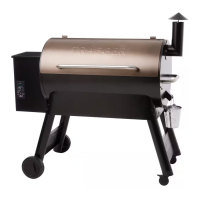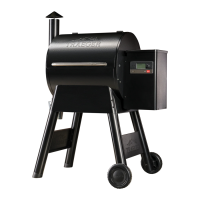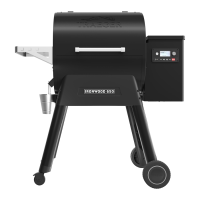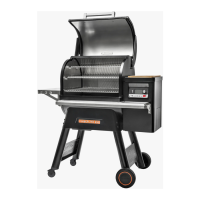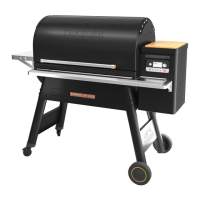22
MAINTAINING YOUR GRILL
CREOSOTE AND GREASE FORMATION
AND REMOVAL
When wood pellets are burned slowly, they produce
tar and other organic vapors that combine with
expelled moisture to form creosote. The creosote
vapors condense in the relatively cool exhaust vent of
a slow-burning re. As a result, creosote accumulates
on the exhaust vent lining. When ignited, creosote
makes an extremely hot re. Airborne grease
particles will travel through the cooking chamber and
may accumulate on the grill louvers (slatted openings
for smoke exhaust) which could contribute to a re.
The Traeger Downdraft Exhaust should be inspected
at least twice a year to determine when a creosote
and/or grease buildup has occurred.
Also, grease drippings from the food will fall onto
the grease drip tray and be channeled into the grease
drain and then out of the grill through the grease
drain tube, to be collected in the grease bucket.
These are the components of the Traeger Grease
Management System (TGMS). Grease will accumulate
in all of these locations.
All components of the TGMS should be inspected
before each use for signs of grease buildup.
When creosote or grease has accumulated, it should
be removed to reduce the risk of re.
Even if there is ample room in the grill, be cautious
of loading excessive amounts of food that can release
large quantities of ammable grease – for example,
more than a pound of bacon – especially if the grill
has not been well-maintained. If your previous cooks
have produced large quantities of ammable grease,
it is highly recommended that the grease be cleaned
from the grill before using it again.
1. CLEANING INSIDE SURFACES:
WARNING!
Turn the Main Power switch OFF (O)
and disconnect the power cord.
CAUTION! Accumulated grease is easier to
clean off when the grill is still warm—not hot.
Be careful not to burn yourself. Gloves are
recommended.
Periodically clean the grease out of the grease
drip tray and grease drain. If too much grease
is allowed to build up in the grease drip tray
or is allowed to plug the grease drain, a grease
re could result. We recommend cleaning these
locations regularly.
Remove the grill grates and the grease drip tray.
Scrape the grease accumulation from inside the
grease drip tray using a stiff, nonmetallic tool.
The drip tray may be washed in hot, soapy
water. Wipe up remaining grease residue with
paper towels or disposable rags. Paper towels
or disposable rags can also be used to wipe
some of the grease off of the interior surfaces
of the grill.
2. CLEANING OUTSIDE SURFACES:
DANGER! Turn the Main Power switch OFF (O)
and disconnect the power cord.
Use a disposable rag or cloth dampened with
warm, soapy water to wipe the grease from the
outside of the grill. DO NOT use oven cleaner,
abrasive cleansers, or abrasive cleaning pads
on the outside grill surfaces.
3. OUTDOOR STORAGE:
CAUTION!
If the grill is stored outdoors
during the rainy season, care should be taken
to ensure that water does not get into the pellet
hopper. Wood pellets expand greatly when wet
and will jam your auger. Always cover your
grill with the Traeger
®
Grill Cover when not
in use. This custom-t cover can be purchased
at traegergrills.com.
4. CLEANING THE GRILL GRATES:
CAUTION!
Cleaning the grill grates works best
while they are still warm. Be careful not to burn
yourself. We recommend keeping a long-handled
cleaning brush near the grill. After removing your
food, give the grill grate a quick brushing. It takes
only a minute and it will be ready the next time
you want to use the grill.
5. CLEANING THE ASH FROM INSIDE AND
AROUND THE FIREPOT (every 20 hours
of use):
DANGER! Turn the Main Power switch OFF (O)
and disconnect the power cord.
WARNING! Make sure that the grill is COLD
before cleaning the ash.
WARNING! Disposal of ashes should be done
only according to the following instructions.
T01364_Ranger_OM_EN.indd 22 9/9/19 8:59 AM
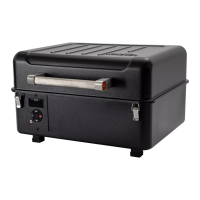
